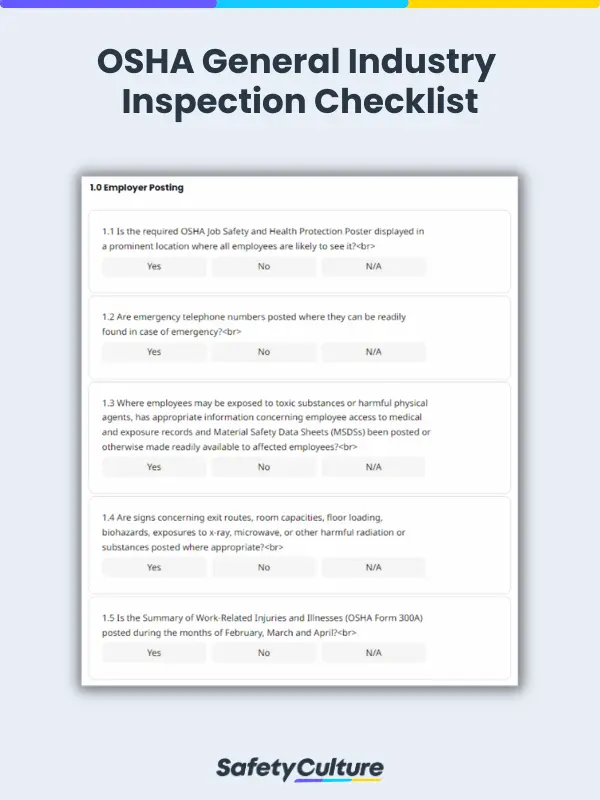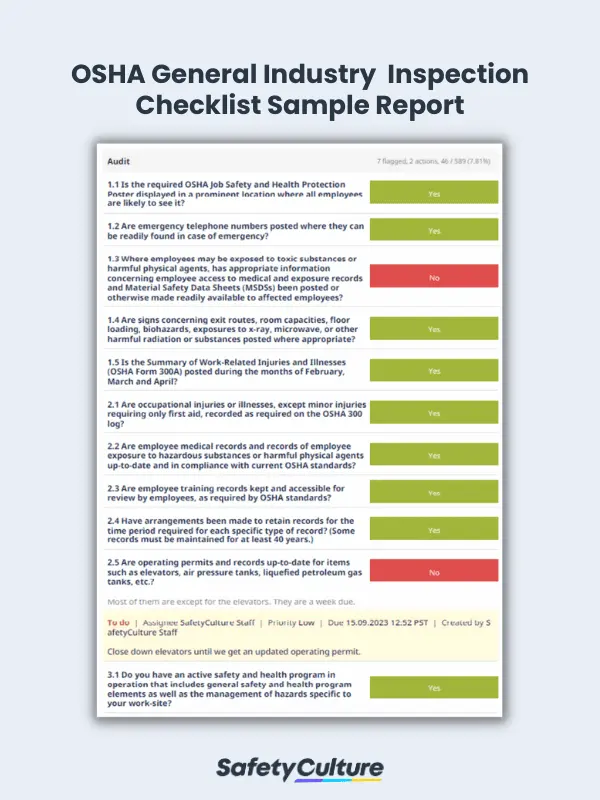What is an OSHA Self Inspection Checklist?
An OSHA self-inspection checklist, also known as a self-audit checklist or self-assessment checklist, is a tool that allows employers, safety professionals, or organizations to conduct their own internal inspections of the workplace to identify and address safety and health hazards. It generally indicates items that aim to meet requirements, enforce industry standards, or implement best practices in compliance with the established regulatory agency, OSHA. Self-inspection checklists differ per organization, but there are a lot of ready-to-use templates that businesses and stakeholders can utilize as guides.
Why is OSHA Inspection Important?
The Occupational Safety and Health Act of 1970 (OSH Act) was passed to prevent workers from being killed or seriously harmed at work. This law created the OSHA to assure safe working conditions by setting and enforcing standards. OSHA also provides information, training, and assistance to employers and workers.
Under the OSH Act, employers have a responsibility to provide a safe workplace. Through the use of OSHA compliance checklists, employers and employees can help each other identify hazards, minimize risk, and improve overall safety in the workplace.
What Does OSHA Look for During an Inspection?
OSHA inspections generally focus on and prioritize workplace sites or areas that are considered the most hazardous. In the same vein, the agency keeps an eye out for potential hazards that are often overlooked, especially in areas of the workplace that are deemed safe and on different types of equipment that are considered harmless.
Complaints received from employees, organizations, other agencies, and the media receive elevated attention and often trigger spontaneous OSHA safety audits. With this, serious injuries and fatalities must be reported to OSHA immediately. This is where and how OSHA determines whether or not certain jobs or industries are hazardous or high-risk.
Then, such high-risk jobs are prioritized by OSHA and have a high chance for more frequent and, often, random inspections. On the other hand, organizations with 10 or fewer employees need not worry because they are exempted from random OSHA safety audits.
All businesses, regardless of industry, should have safety as their top priority. Hence, OSHA inspections should be treated as safeguards to safety precautions already in place, not as threats to scare organizations into creating an effective safety culture. This is how knowing what to expect from an OSHA safety audit and going through the preparation process will help an organization reduce accident rates, review existing safety protocols, and promote job safety.
What are the 3 Parts of an OSHA Inspection?
During an inspection, the OSHA inspector may ask some preliminary questions. It’s vital that a company representative answer these questions as truthfully and accurately as possible. Even if uncertain of the overall safety of the organization, it’s advisable to let the inspector continue as scheduled. Trying to delay an inspection will raise red flags and prompt the OSHA inspector to come back and conduct a more comprehensive inspection.
To give you an overview of how you can prepare and pattern your OSHA safety checklist template, these are the three main parts or phases of an OSHA inspection:
Opening conference
All OSHA safety audits start with the inspector detailing the purpose of the inspection and how it is to be conducted. If triggered by a complaint, this is where copies of the formal complaint are presented. Inspections may include employee interviews, which could be done privately or in the presence of managers, depending on the preferences of the employee.
Facility walkthrough
The OSHA inspector will walk through the facility and take notes and photographs for documentation. The company can choose an employee representative to be present during the walkthrough, but it is not required. Inspections are not limited to any one worksite, regardless of whether or not it was based on a specific complaint. Finding a violation in open view will prompt an OSHA inspector to expand the inspection with the permission of the company.
Closing conference
After a thorough walkthrough of the facility, the OSHA inspector should share findings during the closing conference, including any violations found or unsafe areas or practices observed. Employee representatives should then review the inspector’s recommendations and correct any deficiencies.
OSHA’s inspection checklists typically include the following sections, which can guide you in creating your own self-inspection checklist:
- Employer posting
- Recordkeeping
- Safety and health program
- Medical services and first aid
- Fire protection
- Personal Protective Equipment (PPE) and clothing
- General work environment
- Walkways
- Floor and wall openings
- Stairs and stairways
- Elevated surfaces
- Exiting or egress-evacuation
- Exit doors
- Portable ladders
- Hand tools and equipment
The above are the first 15 sections. Feel free to check other OSHA inspection checklists in our Public Library.
What to Include in Your OSHA Inspection Checklist?
The elements of an OSHA inspection checklist depend on its main purpose. There are plenty of industry-specific checklists that you can use as a guide, but you have to make sure that they would help you comply with the safety standards set by OSHA for your business and industry.
OSHA checklists are often broken down into smaller sections that enable you to inspect work areas in a more detailed manner. Below are some questions you can include in your checklist:
Medical Services and First Aid
OSHA checklists mostly include safety and health-related information. Some of the questions you can ask are the following:
- Is there a hospital, clinic, or infirmary for medical care accessible from your workplace?
- Are first aid kits approved by a physician to indicate that they are adequate for use?
- Are medical personnel readily available for consultation when needed?
- Are emergency phone numbers posted in visible areas?
- Are first aid kits easily accessible to each work area and replenished as needed?
Fire Protection
Aside from being part of OSHA inspection for facilities, it is generally a best practice to ensure that your business has good protection and procedure in case of fires. Consider including these questions in your checklist:
- Can the local fire department easily access your facility’s location in case of emergencies?
- Is the fire alarm system certified as required and tested annually?
- Are fire doors and shutters in good working condition?
- Are the control valves, air, and water pressure of the automatic sprinkler system checked periodically?
- Are portable fire extinguishers in accessible locations, of adequate number, and correct type?
PPE and Clothing
It is also a generally good practice to ensure that your business always observes the wearing of proper protective equipment when needed. Some of the PPE-related questions you can ask are:
- Are there work tasks/activities that require the use of PPE?
- Are protective goggles or face shields worn as needed?
- Are hard hats provided and worn where there is a danger of falling objects?
- Are all PPE regularly cleaned and maintained in a sanitary condition?
- Are both employers and employees trained on PPE procedures?
How to Pass an OSHA Inspection Using Checklists
Establishing a strong workplace safety culture ensures that you need not worry about random OSHA safety audits. It would not hurt, however, to always be prepared so you know how to pass an OSHA safety inspection. The following tips will help make inspections as seamless as possible with the help of an OSHA safety inspection checklist:
Establish a process.
Random inspections are not so random when you know what to do when an inspector shows up. Establish a procedure to be followed in case of OSHA inspections so that employees are prepared. Assign a representative to meet the inspector or auditor and accompany them while doing the facility walkthrough.
Also, make sure that your OSHA facility inspection checklist is updated and easily available.
Keep necessary records at hand.
Inspectors would want to look at your records, so it’s important to keep them organized and accessible. The most important thing, however, is to ensure that you’re keeping complete and accurate records so that you’re prepared for random OSHA safety audits and maintain safety compliance.
Completed OSHA inspection checklists exported into comprehensive reports are considered key records, so make sure these are filed and organized. Here’s an example of how it may look:
Answer all questions as accurately as possible.
OSHA inspections can make employees nervous and make them afraid to say the “wrong” things. Feeling apprehensive is natural, but it’s important to instruct employees that honesty is the best policy during an inspection. Withholding information will backfire and have dire consequences for the organization.
Address issues as soon as possible.
The inspector will point out violations and possible citations; don’t wait for the official citation and address issues immediately after the OSHA safety audit. If you see any other problems not covered in the inspection, address those issues as well. You’re also free to ask the inspector questions so you know how to address specific problem areas.
When doing a self-inspection, leverage the text fields on the checklist to add supporting notes and document corrective actions to ensure proper resolution.
Provide the necessary training programs.
OSHA regulations can change over time, so it’s essential to keep abreast of the latest rules and policies. This is why it’s important to provide appropriate training and safety programs or establish safety regulations for employees and update safety materials and policies regularly.
Remember, OSHA compliance is easily maintained if everyone in the organization knows what to do and how to do it. This includes the proper and effective use of OSHA inspection checklists to prepare well for compliance audits and checks.
Reduce Occupational Risks with OSHA Safety Training
OSHA safety training is essential for businesses to maintain a safe work environment and avoid compliance slip-ups. All workers who are regularly exposed to an array of occupational hazards must be equipped with a working knowledge of safety rules and regulations set by OSHA in order to cut down the risk of illnesses or injuries.
A regular OSHA safety training program also creates an opportunity to spot potential hazards throughout the workplace and examine previous incidents to prevent them from reoccurring. Engaging in safer health practices not only protects a company’s bottom line but also ensures that the safety and security of everyone in the workplace are prioritized.
A myriad of training courses for OSHA safety has been readily available to cater to all busy workers and allow them to take and complete the training at their own pace. To help deploy such courses and programs to workers, using innovative tools like SafetyCulture (formerly iAuditor)’s Training feature is highly recommended.
SafetyCulture Training allows you to create, deliver, and track OSHA inspection and compliance-related training programs to ensure standardization of best practices and control measures in the following areas and more:
- Equipment Safety
- Asbestos Awareness
- Confined Space Construction Risks
- Fall Protection Guidelines
FAQs About OSHA Inspection Checklists
While OSHA safety audit checklists are primarily designed to assess compliance with OSHA regulations and identify workplace hazards during routine inspections, they can also serve as a valuable tool for conducting internal safety audits. The following are just some areas where it can be helpful:
- Compliance Verification
- Continuous Improvement
- Identifying Weaknesses
- Documentation
- Employee Training
OSHA inspection checklists, when used effectively, play a key role in having a positive impact on the overall work environment that shouldn’t be underestimated. Here’s an overview of the aspects it can be deemed helpful:
- Demonstrating Commitment to Safety
- Employee Empowerment (e.g., proactive incident reporting)
- Open Communication
- Recognition of Safe Practices
- Reduced Workplace Stress
- Accident Prevention
- Positive Feedback Loop
Yes, it’s highly advisable to ensure diligent recordkeeping of completed OSHA inspection checklists. Maintaining a comprehensive register of completed checklists serves several important purposes and benefits, both for regulatory compliance and overall safety management, including the following:
- Documentation for Regulatory Compliance
- Evidence of Due Diligence
- Progress Tracking
- Hazard Trends Monitoring
- Continuity and Knowledge Transfer
- Performance Evaluation
- Preparation for Official Inspections
To effectively maintain historical records, consider implementing digital recordkeeping solutions that can simplify the process and facilitate data retrieval when needed. Ultimately, these records are a valuable resource for promoting workplace safety, compliance, and continuous improvement.




